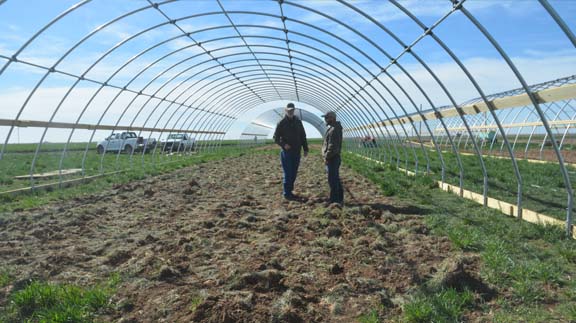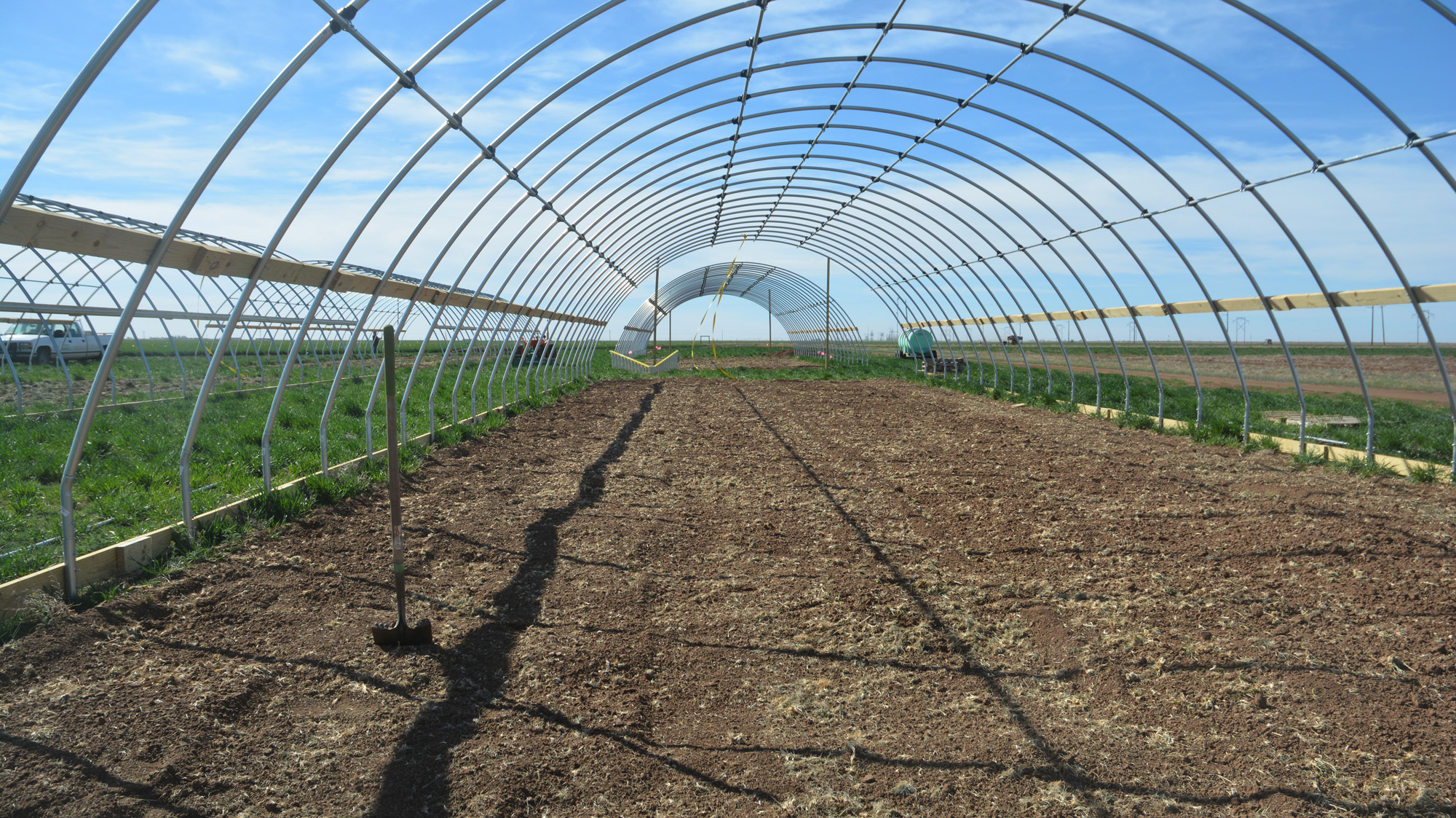Farm & Ranch
[AgriLife Extension] High Tunnels on the High Plains

By: Kay Ledbetter
AgriLife Research eyes vegetables for improved water use
Writer: Kay Ledbetter, 806-677-5608, [email protected]
Contact: Dr. Charlie Rush, 806-354-5804, [email protected]
AMARILLO – When planting season comes around this summer, Dr. Charlie Rush, Texas A&M AgriLife Research plant pathologist in Amarillo, won’t be planting traditional crops or in traditional fields.
Rush is beginning a new project looking at high-value vegetable crop production under high tunnels, particularly tomatoes this year. High tunnels are Quonset hut-type structures similar to greenhouses in appearance but lacking artificial heat.
As water concerns continue to rise, the potential for making more money with the available water is really good, he said, so that’s one of the reasons to look at this new production system with high tunnels and high-value vegetable crops.
“One of the reasons we’re doing this research is because the Ogallala Aquifer is certainly limited and in most cases the water level is dropping,” Rush said. “In areas south of Amarillo particularly, the water availability is becoming scarcer every year.”
It’s more difficult for farmers to pump due to the depth of water and the cost involved, he said.
“So obviously it’s really important that everybody make the most out of every inch of water they apply that they can,” Rush said. “We strongly believe that in some of the areas where they are running out of water, they’re no longer going to be able to grow high-value crops like peanuts or potatoes and even corn, because these all require a lot of water.
“Whereas, if you had a high tunnel, you could grow tomatoes and the amount of money you could make for every inch of water vastly outpaces what you could make on any other crop we’re currently growing in the Panhandle.”

High tunnels, Quonset hut-type structures similar to greenhouses, are large enough to allow some traditional farm equipment to be used in preparing the beds. (Texas A&M AgriLife Communications photo by Kay Ledbetter)
Rush said he has multiple research projects to conduct under the high tunnels with a growing interest being expressed by retailers. H-E-B is currently supporting one project with the Texas Department of Agriculture and United Supermarkets also expressed interest in collaborating.
“The potential for retail grocers to increase availability of high quality vegetables by purchasing from local growers is quite high,” he said.
So far, the frames of four individual high tunnels have been erected with a target date for having tomato seedlings planted by the first week of May, Rush said.
Rush said the tomato cultivars have already been selected and are growing in a greenhouse setting. The seed came from Dr. Kevin Crosby, AgriLife Research vegetable breeder in College Station, and also from some commercial tomato breeders in California.
“The little seedlings are growing and looking great,” Rush said. “They’ll be ready to go by the middle of April, and then it just depends on when we are able to get everything we want done out at the high tunnels as to when we plant the tomatoes there.”
Each high tunnel is 96 feet long, 30 feet wide and 12 feet tall, said Jimmy Gray, AgriLife Research technician in Amarillo. Each will have six, 60-inch beds that will be plowed and shaped up prior to completion of the tunnel building in preparation for planting.
The high tunnel metal frames will be covered with a fiberglass impregnated tarp to allow sunshine in and keep most of the weather out, Gray said. The sides will roll up about 5 feet. The end walls have a 20-foot by 10-foot door that will roll all the way up to allow a breezeway through the high tunnel.
“We are also installing drip tape – both subsurface drip irrigation and root-demand irrigation – along the length of each 5-foot bed,” he said. “We will have three beds per zone and four zones per tunnel, so about 40 foot lengthwise by three 5-foot beds will be one irrigation management zone. And those will be controlled individually with RDI on two of the zones and SDI on two of the zones.”
A similar irrigation setup will be developed in the open field, Rush said. This way researchers and engineers involved in the project can compare vegetable production and water use inside the tunnels and in the open fields.
Rush said this will allow them to conduct precision irrigation and fertilizer practices as they grow tomato plants, and develop best management practices to pass on to producers who adopt high tunnels in the future.
“Eventually, we will look at more than just tomatoes; we will look at all sorts of other specialty crops including vegetables to be grown under high tunnels,” he said. “We’re going to have to work out a cropping system because you can’t grow one vegetable every year inside the entire tunnel, so you need to do just like you would in a field and have rotation schedules.”
Rush said some of the management techniques they will study concern irrigation frequency and method.
“We are excited to look at the new root-demand irrigation,” he said. “Instead of having our traditional subsurface drip or drip tape on top of the bed, root-demand irrigation tape is buried in the bed around the root zone, and as the root grows into contact with that, the roots are actually able to extract water directly from the tape when they need it.”
Once it is installed, Rush said, theoretically producers should not have to worry about irrigation scheduling and the plant should never be exposed to stress because water is always available.
-30-
LikeTweet
Find more stories, photos, videos and audio at http://today.agrilife.org
Farm & Ranch
Managing Show Cattle Through The Winter

By Heather Welper
Husband and wife duo, Heather and Calvin Welper, are the Co-Owners and Operators or Two C Livestock, located in Valley View, Texas.
The pair’s operation has a show cattle focus where they raise and sell purebred heifers of all breeds and club calf Hereford steers.
When it comes to show cattle, the Welpers know a thing or two including how to prepare for the cold winter months and the Texas major show season run.
To read more, pick up a copy of the November edition of North Texas Farm & Ranch magazine, available digitally and in print. To subscribe by mail, call 940-872-5922.

Farm & Ranch
Double M Ranch & Rescue

By Hannah Claxton, Editor
As the sun rises each day, so do the dozens of mouths that Meghan McGovern is responsible for getting fed. Rather than the sounds of a rooster crowing, McGovern hears the bellows and bleats of a variety of exotic deer, the chortle of kangaroos, the grunts of water buffaloes, and the chirps of a lemur.
Nestled against the banks of the Red River, the Double M Ranch and Rescue, with its high game fences and deer sprinkling the landscape,s its in stark contrast to the surrounding ranches.
“Having deer is kind of like eating potato chips- you can never actually have just one,” said McGovern with a laugh.
McGovern has several herds to take care of- fallow deer, axis deer, water buffalo, goats, and bison. In smaller numbers, there’s also a few kangaroos, a lemur, a potbelly pig, a pair of zebras, a watusi, and a few horses.
To read more, pick up a copy of the November edition of North Texas Farm & Ranch magazine, available digitally and in print. To subscribe by mail, call 940-872-5922.

Farm & Ranch
Acorn Toxicity

By Barry Whitworth, DVM, MPH
With the prolonged drought, most pastures in Oklahoma end up in poor condition. With the lack of available forage, animals may go in search of alternative foods.
If oak trees are in the pastures, acorns may be a favorite meal for some livestock in the fall. This may result in oak poisoning.
Oak leaves, twigs, buds, and acorns may be toxic to some animals when consumed.
To read more, pick up a copy of the November edition of North Texas Farm & Ranch magazine, available digitally and in print. To subscribe by mail, call 940-872-5922.

-

 Country Lifestyles2 years ago
Country Lifestyles2 years agoScott & Stacey Schumacher: A Growth Mindset
-

 Country Lifestyles8 years ago
Country Lifestyles8 years agoStyle Your Profile – What your style cowboy hat says about you and new trends in 2017
-

 HOME8 years ago
HOME8 years agoGrazing North Texas – Wilman Lovegrass
-

 Equine1 year ago
Equine1 year agoThe Will to Win
-

 Outdoor10 years ago
Outdoor10 years agoButtercup or Primrose?
-

 Country Lifestyles5 years ago
Country Lifestyles5 years agoAmber Crawford, Breakaway Roper
-

 Country Lifestyles9 years ago
Country Lifestyles9 years agoJune 2016 Profile – The man behind the mic: Bob Tallman
-

 Country Lifestyles8 years ago
Country Lifestyles8 years agoDecember 2016 Profile, Rusty Riddle – The Riddle Way




